Smart Card Market Size
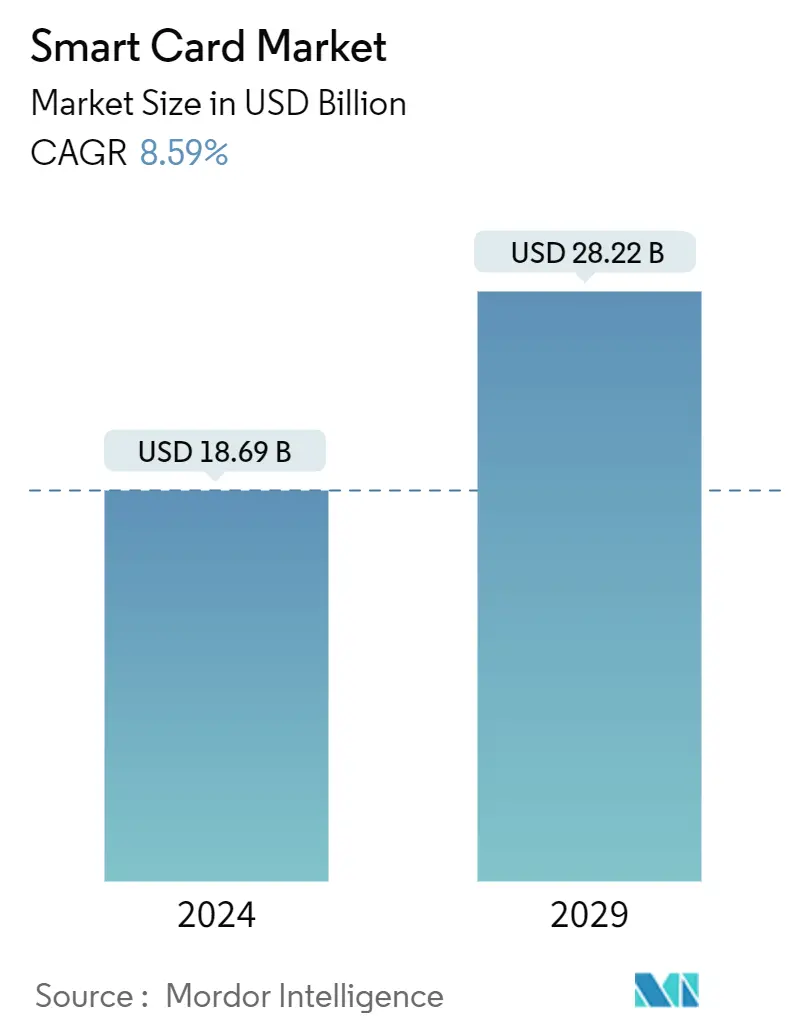
| Study Period | 2019-2029 |
| Market Size (2024) | USD 18.69 Billion |
| Market Size (2029) | USD 28.22 Billion |
| CAGR (2024 - 2029) | 8.59 % |
| Fastest Growing Market | Asia Pacific |
| Largest Market | North America |
| Market Concentration | Low |
Major Players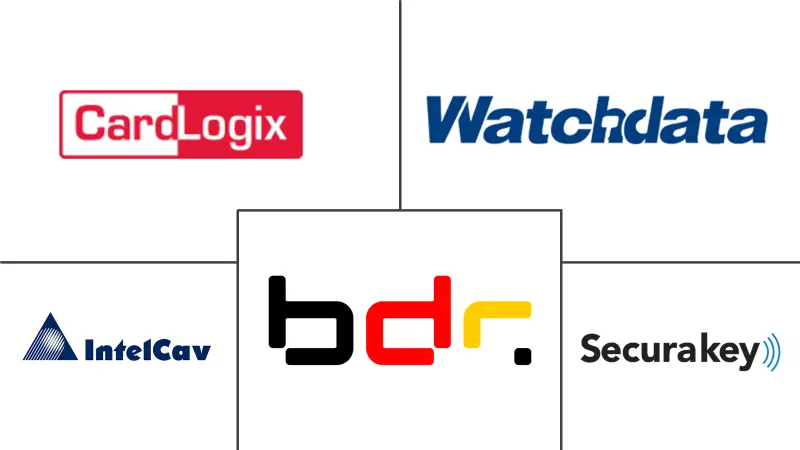
*Disclaimer: Major Players sorted in no particular order |
Smart Card Market Analysis
The Smart Card Market size is estimated at USD 18.69 billion in 2024, and is expected to reach USD 28.22 billion by 2029, growing at a CAGR of 8.59% during the forecast period (2024-2029).
The rising digitalization, increasing demand from online shopping, demand for healthcare, and access control applications are the primary factors augmenting the growth of the smart card market.
- Smart cards provide methods to securely identify and authenticate the cardholder and third parties who want access to the card. For instance, a cardholder can use a PIN code or biometric data for authentication. Smart cards also provide a way to securely store data on the card and protect communications with encryption.
- In an increasingly digital and interconnected world, security concerns have become paramount. Smart cards offer robust security features, including encryption and secure storage of sensitive data, making them an ideal choice for applications that require secure authentication, such as banking, government IDs, and access control.
- The demand for smart cards has been growing each year with applications in various end-use industry markets due to the recent introduction of other security and privacy issues for advanced smart card security applications. Globally, the banking and finance industry is expected to account for a significant share of the smart card market. With critical financial operations being the industry's core, security remains the primary focus. This supports the adoption of advanced authentication solutions and promotes the acceptance of the smart card within the sector.
- The initial cost required for the smart card used for access control and other applications is high as it uses readers and chips of high quality for its functioning. The deployment of readers and chips requires additional costs, which increases the overall cost of smart cards, restraining the growth of smart cards.
- During the COVID-19 pandemic, the business for smart cards specific to telecommunications and healthcare was less affected than other verticals. The upsurge of healthcare data brings up new challenges in providing efficient patient care and privacy. Smart cards solved both challenges by providing secure storage (dramatically more than 150 bytes that can be stored on a magnetic stripe card) and easy data distribution. Increasing healthcare expenditure is anticipated to propel the use of smart cards in the healthcare market.
- For instance, according to the Centers for Medicare & Medicaid Services, US health spending is projected to reach nearly USD 6 trillion by 2027. Moreover, the emergence of COVID-19 has prompted several nations to develop vaccination-proofing plans, which are also anticipated to aid market growth. Digital credentials are expected to play a major role in managing the pandemic.
Smart Card Market Trends
Growing Deployment in Personal Identification and Access Control Applications to Drive the Market Growth
- The smart card market is experiencing significant growth, primarily driven by the expanding deployment of smart cards in personal identification and access control applications. Robust security measures have become paramount in the increasingly digital and interconnected world. Smart cards with advanced microprocessors and secure elements offer an ideal solution for verifying identities and controlling access to sensitive areas or data.
- With the integration of biometric technologies, such as fingerprint scanning, iris recognition, and facial recognition, smart cards provide an added layer of authentication, enhancing security and ensuring user identification accuracy. As a result, various industries, including government, healthcare, finance, and transportation, are increasingly adopting smart cards to secure their identification systems and access control protocols.
- One of the key drivers behind the growing deployment of smart cards in personal identification and access control is the integration of biometric technology. Biometric authentication methods, such as fingerprint scanning, iris recognition, and facial recognition, are gaining prominence due to their accuracy and uniqueness. Smart cards with embedded biometric capabilities add an extra layer of security by binding the cardholder's biometric data to their identification, making it virtually impossible for imposters to gain access.
- Moreover, according to the Biometrics Institute, in 2022, most respondents considered that face recognition was the biometric technology likely to deliver the most significant increase in usage over the next few years. By contrast, only three percent of respondents believed that fingerprint identification would significantly increase usage, as it is already the most used and developed biometric technology. This trend will likely drive the smart card market's growth as businesses and organizations increasingly adopt smart cards with face recognition capabilities to bolster access control and personal identification systems.
- The convenience, reliability, and scalability of smart cards in such applications make them essential tools for organizations seeking to safeguard their operations and protect their users' privacy. This growing deployment in personal identification and access control applications is expected to drive the smart card market's growth further in the coming years as businesses and institutions continue to prioritize security and efficiency in their operations.
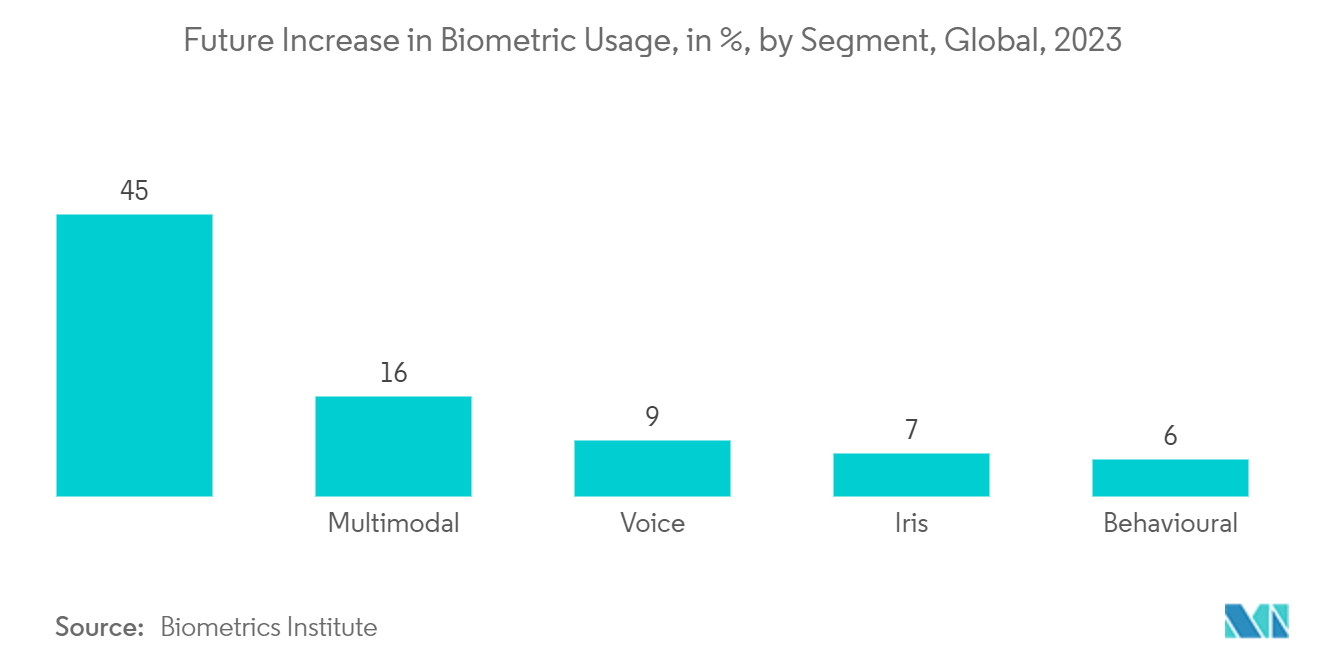
Asia Pacific to Witness a Significant Growth Rate
- Since smart cards are more widely used in the Asia Pacific area, demand from the BFSI, healthcare, retail, and government sectors is likely to dominate the market. Additionally, the growth of IoT applications, smart city projects, and connected devices in the region are creating a demand for secure and scalable authentication solutions, where smart cards play a crucial role. Moreover, the growing awareness of data security and privacy concerns is encouraging enterprises and organizations to adopt smart cards for access control and secure data storage.
- A big consumer base and the presence of major smart card manufacturers in China are expected to result in a strong demand for smart cards in the region. Smart cards were adopted by a number of banking institutions, which helped the market expand.
- For instance, China Construction Bank (CCB) declared last year that they are testing a biometric 'hard wallet' smart card that enables users to store digital yuan and confirm payments made using the central bank's digital currency with their fingerprints. With the help of cutting-edge fingerprint authentication and recognition, the stored value on the card is further protected.
- To establish various types of smart cards in the nation, several banks operating in the region have partnered with smart card creators. Axis Bank, ICICI Bank, and SBM Bank are a few Indian banks that released smart cards in the latter or first quarter of the previous year.
- In addition, MoriX Co., a Tokyo-based electronics company, collaborated with Fingerprint Cards AB last year to develop and introduce biometric payment cards using the T-Shape module from Fingerprints. These cards are anticipated to be integrated with payment cards using conventional automated manufacturing techniques.
- To support market expansion, new initiatives, and developments are encouraging other end users to use smart cards. Transit cards were recently offered for users of public transportation in more than 300 Chinese cities by Octopus, one of the smart card operators in Hong Kong. Users of Octopus transit cards will be able to pay for public transportation in mainland China's buses, trains, and ferries as part of the company's offshore development plan. The maximum top-up amount for the Octopus card will initially be HKD 3,000 (USD 386), with the option to convert to digital Octopus cards in a phase two launch.
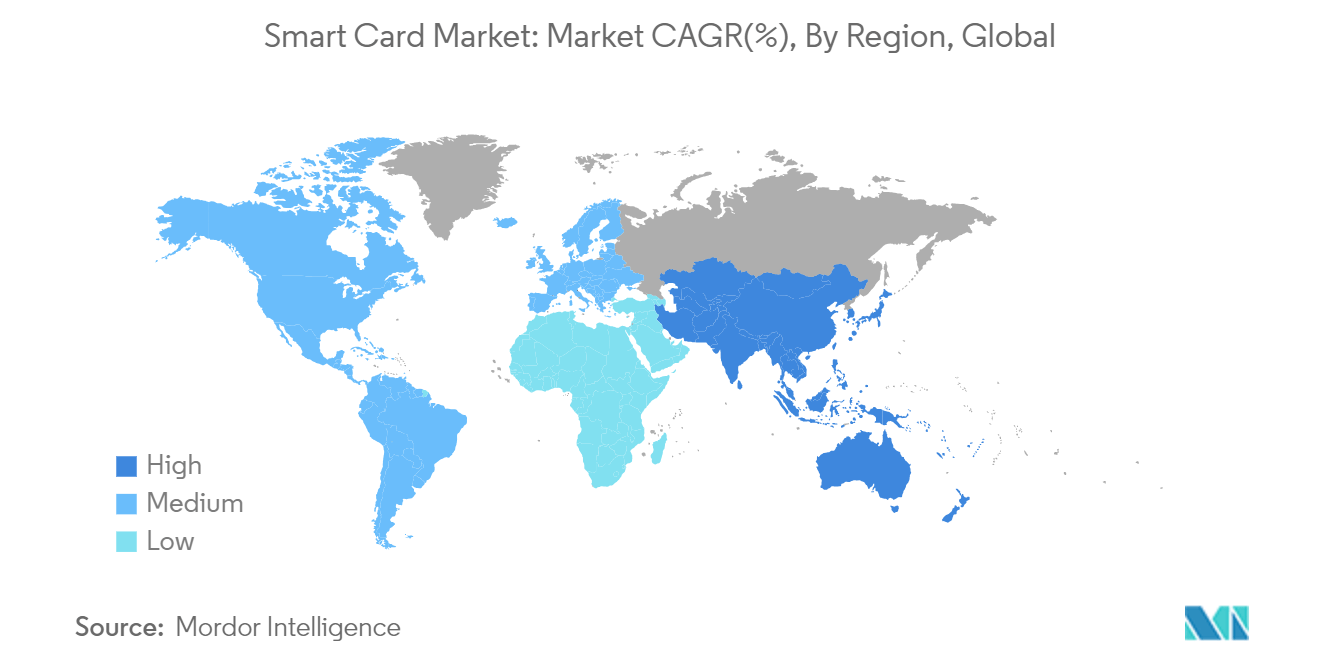
Smart Card Industry Overview
The Smart Card market is fragmented because of the presence of several global companies. Some key players are HID Global Corporation, CardLogix Corporation, Thales Group, etc. Key players in this market are introducing new innovative products and forming partnerships and collaborations to gain competitive advantages.
- July 2023- IDEX Biometrics announced a global collaboration with Goldpac Fintech Hong Kong Limited, a Goldpac Group company, to deploy biometric smart cards based on IDEX Biometrics' complete fingerprint solution for payments and identity access.
- January 2023: To enhance the convenience of passengers, the Delhi Metro has collaborated with Airtel Payments Bank, offering an additional smart card top-up facility. Customers' Internet banking details will be securely stored within the app, ensuring the utmost safety for all transactions. Taking advantage of this feature for recharging purposes will be both swift and effortless, providing a seamless experience for commuters.
Smart Card Market Leaders
-
CardLogix Corporation
-
Watchdata Technologies
-
Bundesdruckerei GmbH
-
IntelCav
-
Secura Key
*Disclaimer: Major Players sorted in no particular order
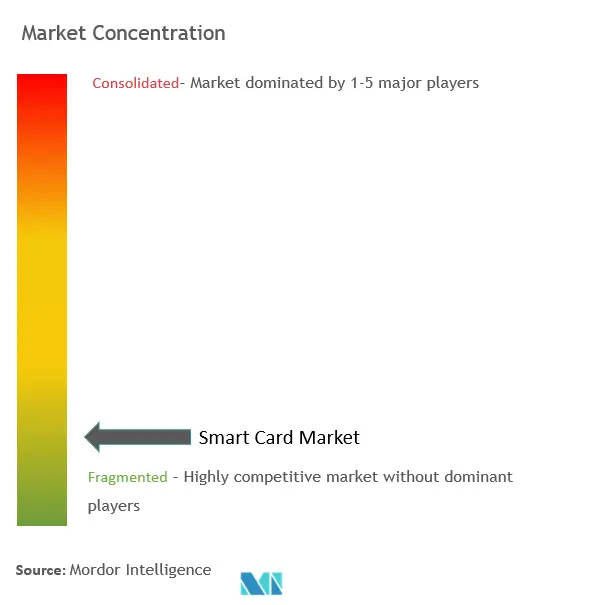
Smart Card Market News
- April 2023: The GoSmart National Common Mobility Card was launched for passengers using the Kanpur metro in India. The NCMC card was initially introduced in Uttar Pradesh by the Kanpur Metro. The primary advantage of this card is that it is an interchangeable transport card, meaning that it may be used for other NCMC-compliant retail, parking, metro, bus, and other transportation services throughout the nation. Travelers can easily traverse the entire nation with the NCMC card. Along with facilitating smooth mobility, this also helps travelers save time and energy.
- January 2023: A new innovation center dedicated solely to next-generation card technologies with a dedication to sustainability was inaugurated by dzcard, a prominent secured smart card solution and digital security provider in Southeast Asia. The Bangkok, Thailand lab will serve as a platform for co-creating goods with dzcard's clients and partners. The lab's focus is on creating and evaluating solutions and products that are sustainability-oriented.
Smart Card Market Report - Table of Contents
1. INTRODUCTION
1.1 Study Assumptions and Market Definition
1.2 Scope of the Study
2. RESEARCH METHODOLOGY
3. EXECUTIVE SUMMARY
4. MARKET INSIGHT
4.1 Market Overview
4.2 Industry Attractiveness - Porter's Five Forces Analysis
4.2.1 Bargaining Power of Suppliers
4.2.2 Bargaining Power of Buyers
4.2.3 Threat of New Entrants
4.2.4 Threat of Substitutes
4.2.5 Intensity of Competitive Rivalry
4.3 Industry Value Chain Analysis
4.4 Assessment of the Impact of COVID-19 on the Market
5. MARKET DYNAMICS
5.1 Market Drivers
5.1.1 Growing Deployment in Personal Identification and Access Control Applications
5.1.2 Extensive Use in Travel Identity and Transportation
5.1.3 Growing Demand for Contactless Payments
5.2 Market Restraints
5.2.1 Privacy and Security Issues and Standardization concerns
6. MARKET SEGMENTATION
6.1 By Type
6.1.1 Contact-based
6.1.2 Contact-Less
6.2 By End-user Vertical
6.2.1 BFSI
6.2.2 IT & Telecommunication
6.2.3 Government
6.2.4 Transportation
6.2.5 Other End-User Industries (Education, Healthcare, Entertainment, etc.)
6.3 By Geography
6.3.1 North America
6.3.1.1 United States
6.3.1.2 Canada
6.3.2 Europe
6.3.2.1 United Kingdom
6.3.2.2 Germany
6.3.2.3 France
6.3.2.4 Rest of Europe
6.3.3 Asia Pacific
6.3.3.1 China
6.3.3.2 Japan
6.3.3.3 India
6.3.3.4 Rest of Asia Pacific
6.3.4 Rest of the World
7. COMPETITIVE LANDSCAPE
7.1 Company Profiles
7.1.1 CardLogix Corporation
7.1.2 Watchdata Technologies
7.1.3 Bundesdruckerei GmbH
7.1.4 IntelCav
7.1.5 Secura Key
7.1.6 Alioth LLC
7.1.7 Gemalto NV (Thales Group)
7.1.8 Giesecke & Devrient GmbH (MC Familiengesellschaft mbH)
7.1.9 HID Global Corporation (Assa Abloy AB)
7.1.10 IDEMIA France SAS
7.1.11 Infineon Technologies AG
7.1.12 Fingerprint Cards AB
7.1.13 Samsung Electronics Co. Ltd
7.1.14 CPI Card Group Inc.
7.1.15 KONA I Co. Ltd
- *List Not Exhaustive
8. VENDOR POSITIONING ANALYSIS
9. INVESTMENT ANALYSIS
10. FUTURE OF THE MARKET
Smart Card Industry Segmentation
A smart card is a small plastic card embedded with an integrated circuit chip. It is capable of storing and processing data securely. Smart cards are used in various applications such as identification, authentication, payment systems, access control, and secure data storage.
The smart card market is segmented by type (contact-based and contactless), end-user vertical (BFSI, IT & telecommunication, government, transportation), and geography (North America [United States, Canada], Europe [United Kingdom, Germany, France, Rest of Europe], Asia Pacific [China, Japan, India, Rest of Asia Pacifi]), and Rest of the World). The market sizes and forecasts are provided in terms of value in USD for all the above segments.
| By Type | |
| Contact-based | |
| Contact-Less |
| By End-user Vertical | |
| BFSI | |
| IT & Telecommunication | |
| Government | |
| Transportation | |
| Other End-User Industries (Education, Healthcare, Entertainment, etc.) |
| By Geography | ||||||
| ||||||
| ||||||
| ||||||
| Rest of the World |
Smart Card Market Research FAQs
How big is the Smart Card Market?
The Smart Card Market size is expected to reach USD 18.69 billion in 2024 and grow at a CAGR of 8.59% to reach USD 28.22 billion by 2029.
What is the current Smart Card Market size?
In 2024, the Smart Card Market size is expected to reach USD 18.69 billion.
Who are the key players in Smart Card Market?
CardLogix Corporation, Watchdata Technologies, Bundesdruckerei GmbH, IntelCav and Secura Key are the major companies operating in the Smart Card Market.
Which is the fastest growing region in Smart Card Market?
Asia Pacific is estimated to grow at the highest CAGR over the forecast period (2024-2029).
Which region has the biggest share in Smart Card Market?
In 2024, the North America accounts for the largest market share in Smart Card Market.
What years does this Smart Card Market cover, and what was the market size in 2023?
In 2023, the Smart Card Market size was estimated at USD 17.08 billion. The report covers the Smart Card Market historical market size for years: 2019, 2020, 2021, 2022 and 2023. The report also forecasts the Smart Card Market size for years: 2024, 2025, 2026, 2027, 2028 and 2029.
Smart Card Industry Report
Statistics for the 2024 Smart Card market share, size and revenue growth rate, created by Mordor Intelligence™ Industry Reports. Smart Card analysis includes a market forecast outlook to 2029 and historical overview. Get a sample of this industry analysis as a free report PDF download.



